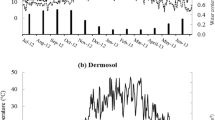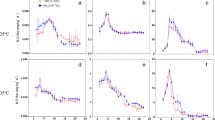Abstract
Purpose
Although nitrification plays a key role in the fate of soil nitrogen (N) under global warming, little information is available for the nitrifiers’ response to changing temperatures. Nitrogen isotope fractionation associated with nitrification can be a proxy of nitrifiers’ sensitivity to changing temperature. We hypothesized that the temperature-induced balance between the transport of substrate NH +4 into the microbial cell (supply) and the intracellular NH +4 oxidation (consumption) governs the intracellular NH +4 concentration and then affects nitrification rates and associated isotope fractionations. This study was conducted to understand the microbial response of NH +4 oxidation to changing temperatures by examining the effect of changing temperature on nitrification rate and apparent isotope fractionation.
Materials and methods
A batch aerobic incubation was conducted with a sandy loam soil over 150 days at three different soil temperatures: 10, 20, and 30°C. After applying ammonium sulfate, we analyzed the temporal variations in the concentrations and the isotopic compositions of soil inorganic N and calculated nitrification rates and isotope fractionation factors.
Results and discussion
Net nitrification rate increased with increasing soil temperature, while apparent isotope fractionation factors decreased. The increased net nitrification rate was attributable to both an increase in NH +4 transport across cell membranes and an increase in intracellular enzymatic activity. Meanwhile, the decreased apparent isotope fractionation suggested that NH +4 oxidation rate became faster than NH +4 transport rate, resulting in a decrease in intracellular NH +4 concentrations.
Conclusions
Although intracellular NH +4 transport and oxidation were not directly measured in this study, it is concluded that NH +4 oxidation is more sensitive to increasing temperature than NH +4 transport judging from the apparent N isotopic fractionation associated with NH +4 concentration changes (mainly by nitrification) under different temperature regimes.







Similar content being viewed by others
References
Bárcenas-Moreno G, Gómes-Brandón M, Rousk J, Bååth E (2009) Adaptation of soil microbial communities to temperature: comparison of fungi and bacteria in a laboratory experiment. Glob Change Biol 15:2950–2957
Breuer L, Kiese R, Butterbach-Bahl K (2002) Temperature and moisture effects on nitrification rates in tropical rain-forest soils. Soil Sci Soc Am J 66:834–844
Buresh RJ, Patrick WH (1978) Nitrate reduction to ammonium in anaerobic soils. Soil Sci Soc Am J 42:913–918
Casciotti KL, Sigman DM, Ward BB (2003) Linking diversity and stable isotope fractionation in ammonia-oxidizing bacteria. Geomicrobiol J 20:335–353
Choi WJ, Ro HM (2003) Differences in isotopic fractionation of nitrogen in water-saturated and unsaturated soils. Soil Biol Biochem 35:483–486
Choi WJ, Ro HM, Lee SM (2003) Natural 15N abundances of inorganic nitrogen in soil treated with fertilizer and compost under changing soil moisture regimes. Soil Biol Biochem 35:1289–1298
Dijkstra P, LaViolette CM, Coyle JS, Doucett RR, Schwartz E, Hart SC, Hungate BA (2008) 15N enrichment as an integrator of the effects of C and N on microbial metabolism and ecosystem function. Ecol Lett 11:389–397
Farquhar GD, Ehleringer JR, Hubick KT (1989) Carbon isotope discrimination and photosynthesis. Annu Rev Plant Physiol Plant Mol Biol 40:503–537
Fiencke C, Spieck E, Bock E (2005) Nitrifying bacteria. In: Werner D, Newton WE (eds) Nitrogen fixation in agriculture, forestry, ecology, and the environment. Springer, Dordrecht, pp 255–276
Hoefs J (1997) Stable isotope geochemistry. Springer-Verlag, Berlin, pp 1–26
Högberg P (1997) Tansley review no. 95: 15N natural abundance in soil-plant systems. New Phytol 137:179–203
Hoyle FC, Murphy DV, Fillery IRP (2006) Temperature and stubble management influence microbial CO2–C evolution and gross N transformation rates. Soil Biol Biochem 38:71–80
Humbert S, Tarnawski S, Fromin N, Mallet MP, Aragno M, Zopfi J (2010) Molecular detection of anammox bacteria in terrestrial ecosystems: distribution and diversity. ISME J 4:450–454
Ishimori T (1959) The nitrogen isotopic equilibrium between ammonia and ammonium ion. Bull Chem Soc Jpn 33:516–519
Keeney DR, Nelson DW (1982) Nitrogen-inorganic forms. In: Page AL (ed) Methods of Soil Analysis. Part 2: Chemical and Microbiological Properties, ASA and SSSA, Madison, pp 643–698
Kerley SJ, Jarvis SC (1996) Preliminary studies of the impact of excreted N on cycling and uptake of N in pasture systems using natural abundance stable isotope discrimination. Plant Soil 178:287–294
Koops HP, Pommerening-Roser A (2001) Distribution and ecophysiology of the nitrifying bacteria emphasizing cultured species. FEMS Microbiol Ecol 37:1–9
Malhi SS, McGill WB (1982) Nitrification in three Alberta soils: effect of temperature, moisture and substrate concentration. Soil Biol Biochem 14:393–399
Mariotti A, Germon JC, Hubert P, Kaiser P, Letolle R, Tardieux A, Tardieux P (1981) Experimental determination of nitrogen kinetic isotope fractionation: some princinples; illustration for the denitrification and nitrification processes. Plant Soil 62:413–430
Mariotti A, Mariotti F, Champigny ML, Amarger N, Moyse A (1982) Nitrogen isotope fractionation associated with nitrate reductase activity and uptake of NO –3 by Pearl Millet. Plant Physiol 69:880–884
Matulewich VA, Strom PF, Finstein MS (1975) Length of incubation for enumerating nitrifying bacteria present in various environments. Appl Environ Microbiol 65:213–220
Melillo JM, Steudler PA, Aber JD, Newkirk K, Lux H, Bowles FP, Catricala C, Magill A, Ahrens T, Morrisseau S (2002) Soil warming and carbon-cycle feedbacks to the climate system. Science 298:2173–2176
Nedwell DB (1999) Effect of low temperature on microbial growth: lowered affinity for substrates limits growth at low temperature. FEMS Microbiol Ecol 30:101–111
Robinson D (2001) δ15N as an integrator of the nitrogen cycle. Trends Ecol Evol 16:153for
Robinson D, Handley LL, Scrimgeour CM (1998) A theory for 15N/14N fractionation in nitrate-grown vascular plants. Planta 205:397–406
Schmidt I, Look C, Bock E, Jetten MSM (2004) Ammonium and hydroxylamine uptake and accumulation in Nitrosomonas. Microbiology 150:1405–1412
Shearer GB, Kohl DH (1986) N2 fixation in field settings: estimations based on natural 15N abundance. Aust J Plant Physiol 13:699–757
Stark JM, Firestone MK (1996) Kinetic characteristics of ammonium-oxidizer communities in a California oak woodland-annual grassland. Soil Biol Biochem 28:1307–1317
Urey HC (1947) The thermodynamic properties of isotopic substances. J Chem Soc 1947:562–581
Ventura WB, Yoshida T (1977) Ammonia volatilization from a flooded tropical soil. Plant Soil 46:521–531
Wang C, Wan S, Xing X, Zhang L, Han X (2006) Temperature and soil moisture interactively affected soil net N mineralization in temperate grassland in Northern China. Soil Biol Biochem 38:1101–1110
Wijler J, Delwiche CC (1954) Investigations on the denitrifying process in soil. Plant Soil 5:155–169
Yun SI, Ro HM (2009) Natural 15N abundance of plant and soil inorganic-N as evidence for over-fertilization with compost. Soil Biol Biochem 41:1541–1547
Yun SI, Ro HM, Choi WJ, Chang SX (2006) Interactive effects of N fertilizer source and timing of fertilization leave specific N isotopic signatures in Chinese cabbage and soil. Soil Biol Biochem 38:1682–1689
Zaman M, Chang SX (2004) Substrate type, temperature, and moisture content affect gross and net N mineralization and nitrification rates in agroforestry systems. Biol Fertil Soils 39:269–279
Acknowledgments
Three anonymous reviewers provided helpful comments and criticism, which improved the manuscript. The authors acknowledge with appreciation Dr. Sang-Mo Lee of the National Instrumentation Center for Environmental Management, Seoul National University for helping the use of stable isotope ratio mass spectrometer and Mr. Jae-Min Kim and Ms. Min-Jin Lee for their laboratory assistance in N isotope analysis. This research was funded not only by the Brain Korea 21 Program of the Ministry of Education, Science and Technology in Korea but also by the support of “Cooperative Research Program for Agriculture Science and Technology Development (Project No. PJ007455),” Rural Development Administration, South Korea.
Author information
Authors and Affiliations
Corresponding author
Additional information
Responsible editor: Ji-Zheng He
Rights and permissions
About this article
Cite this article
Yun, SI., Ro, HM., Choi, WJ. et al. Interpreting the temperature-induced response of ammonia oxidizing microorganisms in soil using nitrogen isotope fractionation. J Soils Sediments 11, 1253–1261 (2011). https://doi.org/10.1007/s11368-011-0380-1
Received:
Accepted:
Published:
Issue Date:
DOI: https://doi.org/10.1007/s11368-011-0380-1




